
Lupinus polyphyllus is a species of lupine (lupin) native to western North America from southern Alaska and British Columbia east to Quebec, and western Wyoming, and south to Utah and California. It commonly grows along streams and creeks, preferring moist habitats.
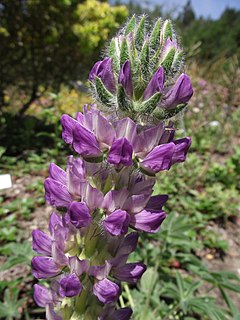
Lupinus microcarpus, the wide-bannered lupine or chick lupine, is a species of lupine native to western North America from southwestern British Columbia south through Oregon and California, including the Mojave Desert, and into Baja California. There is also a disjunct population in South America, with locations in central Chile and western Argentina.
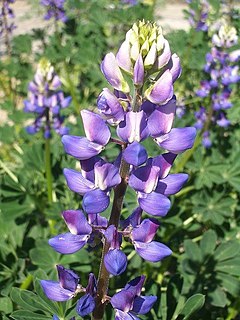
Lupinus succulentus is a species of lupine known by the common names hollowleaf annual lupine, arroyo lupine, and succulent lupine.
Lupinus adsurgens is a species of lupine known by the common name Drew's silky lupine. It is native to the Sierra Nevada and coastal mountain ranges of northern California and southern Oregon, where it grows in forest and other mountain habitat. It is a perennial herb growing 20–60 centimetres (7.9–23.6 in) in height. Each palmate leaf is made up of 6 to 9 leaflets each up to 5 centimetres (2.0 in) long. The herbage is hairy and silvery or gray-green in color. The inflorescence is up to 23 centimetres (9.1 in) long, bearing flowers just over a centimeter long. The flower is pale pink or purple to yellowish with a white or yellow patch on the banner. The fruit is a silky-haired legume pod 2 to 4 centimetres (1.6 in) long containing 3 to 6 seeds.
Lupinus affinis is a species of lupine known by the common name fleshy lupine. It is native to the California Coast Ranges from the San Francisco Bay Area north, and into southern Oregon, where it is an uncommon member of the flora in several areas. It is a hairy annual herb growing 20 to 50 centimetres in height. Each palmate leaf is made up of 5 to 8 leaflets each up to 5 centimetres long. The inflorescence is up to 20 centimetres (8 in) long, bearing whorls of flowers each about 1 centimetre long. The flower is purple-blue with a whitish patch on the banner. The fruit is a hairy legume pod up to 5 centimetres (2 in) long containing several seeds.
Lupinus antoninus is a rare species of lupine known by the common name Anthony Peak lupine. It is endemic to northern California, where it is known from only four occurrences in the North Coast Ranges, including near Anthony Peak.
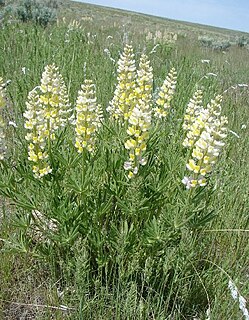
Lupinus arbustus is a species of lupine known by the common name longspur lupine. It is native to western North America from British Columbia to California to Utah, where it grows in several types of habitat, including sagebrush and forests. This is a perennial herb growing erect to a maximum of 70 centimetres tall. It is sometimes hairy in texture. Each palmate leaf is made up of 7 to 13 leaflets each up to 7 centimetres long. The inflorescence is up to 18 centimetres long, bearing whorls of flowers each up to 1.4 centimetres long. The calyx of sepals around the base of the corolla has a knoblike spur at the back. The flower corolla is white to yellow to various shades of purple or pink. The fruit is a hairy legume pod 2 or 3 centimetres long. There are several subspecies.
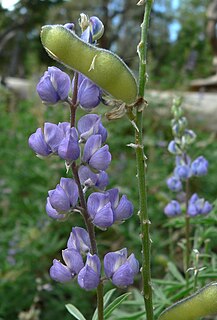
Lupinus argenteus is a species of lupine known by the common name silvery lupine. It is native to much of western North America from the southwestern Canadian provinces to the southwestern and midwestern United States, where it grows in several types of habitat, including sagebrush, grassland, and forests. This is a perennial herb growing erect to heights anywhere between 10 centimetres (3.9 in) and 1.5 metres (4.9 ft). It is sometimes silvery-hairy in texture and sometimes nearly hairless. Each palmate leaf is made up of 5 to 9 leaflets each up to 6 centimetres long. They are narrow and linear in shape, under a centimetre wide. The inflorescence bears many flowers, sometimes arranged in whorls. The flower is 5 millimetres (0.20 in) to 14 millimetres (0.55 in) long and purple, blue, or whitish in color. The banner, or upper petal, of the flower may have a patch of white or yellow. The fruit is a hairy legume pod up to 3 centimeters long containing several beanlike seeds.

Lupinus benthamii is a species of lupine known by the common name spider lupine.
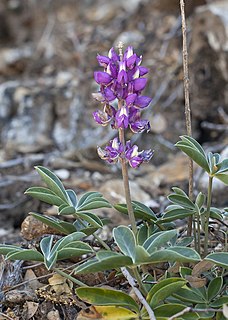
Lupinus cervinus is a species of lupine known by the common name Santa Lucia lupine. It is endemic to the Santa Lucia Mountains in the Central Coast Ranges in California, where it is an uncommon member of the flora in the mountain forests. This is a hairy gray-green perennial herb growing up to 30–70 centimetres (12–28 in) tall. The erect stem is surrounded by clusters of spreading leaves. Each palmate leaf is made up of 4 to 8 leaflets up to 8 centimetres (3.1 in) long and 3 centimetres (1.2 in) wide, which is wider than the leaflets of most lupines. The inflorescence bears many flowers, sometimes in whorls, each between 1 centimetre (0.39 in) and 2 centimetres (0.79 in) long. The flower is often bright pink, but may be shades of blue to nearly white. There is often a yellow patch on the banner. The fruit is a hairy legume pod up to 6 centimetres (2.4 in) long.
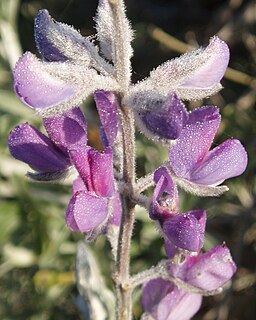
Lupinus chamissonis is a species of lupine known by the common name Chamisso bush lupine. It is endemic to California, where it is known from most of the length of the coastline. It grows in sand dunes and other immediate coastal habitat.
Lupinus covillei is a species of lupine known by the common name shaggy lupine.

Lupinus flavoculatus is a species of lupine known by the common name yelloweyes, or yellow-eyed lupine.,
Lupinus grayi is a species of lupine known by the common name Sierra lupine. It is endemic to California, where its distribution extends the length of the Sierra Nevada and its foothills and includes the Tehachapi Mountains.

Lupinus hirsutissimus is a species of lupine known by the common names stinging annual lupine or stinging lupine. It is native to the coastal mountains of Baja California and Southern California as far north as the San Francisco Bay Area. It grows on dry mountain slopes, including areas that have recently burned, and chaparral and woodlands habitats.
Lupinus holmgrenianus is a species of lupine known by the common name Holmgren's lupine. It is native to the desert mountains of western Nevada and a few ranges of adjacent Inyo County, California, including the Last Chance Range of Death Valley National Park. This is a hairy perennial herb growing erect to a maximum height near 70 centimetres (28 in). Each palmate leaf is made up of 4 to 7 leaflets up to 5 centimetres (2.0 in) long. The inflorescence is a spiral of flowers each just over a centimeter long. They are purple in color with yellow patches on their banners. The fruit is a hairy legume pod 4 or 5 centimeters long.
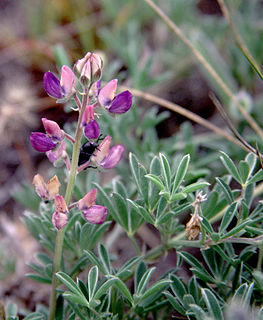
Lupinus littoralis is a species of lupine known by the common name seashore lupine. It is native to the coastline of western North America from British Columbia to northern California, where it grows in sandy habitat. It is a low perennial herb or subshrub growing in a clump or mat no more than 30 centimetres (12 in) tall. Each palmate leaf is divided into 5 to 9 leaflets up to 3.5 centimetres (1.4 in) long. The herbage is coated in long, shaggy whitish or silvery hairs. The inflorescence is raceme of whorled flowers each around a centimeter long. The flower is purple in color with a white patch on its banner that fades pinkish. The fruit is a hairy legume pod 3 or 4 centimeters long containing up to 12 seeds.
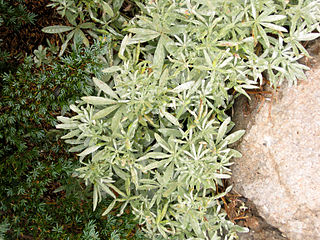
Lupinus obtusilobus is a species of lupine known by the common name bluntlobe lupine. It is native to high mountains of northern California, including the North Coast Ranges, the Klamath Mountains, and the northernmost Sierra Nevada. It grows in various types of mountain habitat, sometimes carpeting meadows with its purple blooms in the spring. It is a perennial herb growing erect or decumbent along the ground, its stem 15–30 centimetres (5.9–11.8 in) long. Each palmate leaf is made up of 6 to 7 leaflets up to 5 centimetres (2.0 in) long. The herbage is coated in silvery silky hairs. The inflorescence is a small raceme with a few whorls of flowers each just over a centimeter long. The flower is blue to purple with a yellowish patch on its banner. The fruit is a silky-haired legume pod up to 4 centimetres (1.6 in) long.
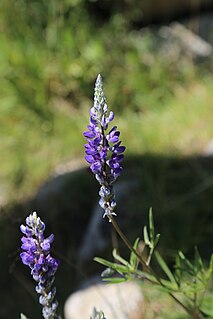
Lupinus pratensis is a species of lupine known by the common name Inyo meadow lupine. It is endemic to California, where it grows in the central Sierra Nevada and adjacent plateau and valleys to the east. It grows in relatively moist habitat, such as streambanks and spring meadows. This is an erect perennial herb growing 30–70 centimetres (12–28 in) tall. Each palmate leaf is made up of 5 to 10 narrow leaflets sometimes exceeding 10 centimetres (3.9 in) long. The leaves are borne on long petioles which can reach 25 centimetres (9.8 in) in length. The herbage is green and coated in thin hairs. The inflorescence is a dense raceme of many flowers each around a centimeter long. The flower is dark blue or purple with a reddish or orange patch on its banner. The fruit is a hairy legume pod around 2 centimetres (0.79 in) long.

Lupinus sericeus is a species of flowering plant in the legume family known by the common name silky lupine or Pursh's silky lupine. It is native to western North America from British Columbia to Arizona and east to Alberta and Colorado.



















